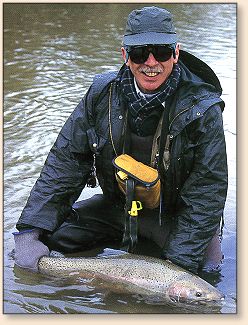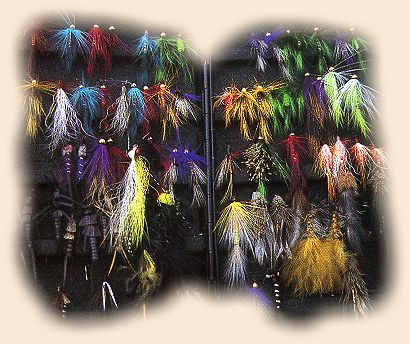Lake Erie Streams
By Scott E. Smith
Since the 1930s Lake Erie has been thorough a
multitude of changes. The lake suffered through
progressive water quality deterioration up until
the 1970s when a multi-national agreement was
signed to reduce phosphate levels in Lake Erie.
The lake's indigenous population of lake trout
and whitefish, and introduced salmonids, had been
all but decimated by enormous algae blooms that
robbed the lake of oxygen. Within ten years of
this agreement the lake responded remarkably,
becoming renowned as a walleye and perch hot-bed.
Just as this great fishery began perking along
nicely the invasion of zebra mussels in the late
80s began. This invasion changed the mesotrophic
and even eutrophic water conditions to a clear-water,
nutrient-poor situation that resembled the open waters
of Lake Superior. At present visibility in Lake Erie
approaches thirty-five feet in some areas. Quite a
change from the three-foot visibility conditions
during the height of the algae bloom, in the 1970s.
However nature always seems to adapt, providing good
with bad. This clear-water condition now prevalent
in the lake, is very desirable for the steelhead
population although its not so good for the walleye.
Charter boat companies that a few years ago targeted
large walleyes are now hooking up routinely with
jazzed steelhead in the open waters of Lake Erie.
Because of varying depth ranges in the lake, warm
water species and salmonids are seeking out their
own niche within this body of water. These factors,
combined with the improvements in water quality and
spawning habitat within the catchment tributaries
of the Grand River and Big Creek, coalesce nicely
resulting in a blossoming steelhead fishery. Each
year better returns and additional angling opportunities
are appearing in these tributary systems. One can
only hope that this trend continues.

Most steelhead and salmon found in Ontario's Lake Erie
tributaries were originally stocked in U.S. waters
(thanks guys!). With the exception of the Grand River,
the best return of salmonids of salmonids occurs in the
streams of Norfolks sand plain in the Long Point Bay
area. This large sand plain, in places one-hundred
feet deep, acts as a filter system for cool ground
water, which in turn makes area tributaries ideal
spawning habitat. The streams in the area are sandy,
clear and cool, and under favourable conditions fish
well for steelhead, salmon and migratory browns.
Lake Erie steelhead average between four and seven
pounds when sexually mature, with a number of fish
between nice and twelve pounds. Few steelhead
exceed this mark, however recently specimens in
the fifteen- to twenty-pound class have been reported.
Biologists hypothesize that this may be attributed
to increasingly favourable forage condition in the
lake (steelhead feed primarily by sight), or the
recent introduction of Little Manistee strain steelhead
in Ohio (thanks once again). Recently a twenty-six
pound behemoth was boated off the mouth of Big Otter
Creek by a down-rigging angler.
The prognosis for the steelhead fishery, specifically
in the Big Creek and Grand River drainage, is good,
and may rival the best fisheries in Ontario in coming
years.
Timing for Lake Erie steelhead is similar to most
Southern Ontario spring and fall timings. On most
streams summer steelhead are as likely as finding a
nugget of gold, but on Young Creek, a small, tightly
treed, tributary in the Long Point Bay drainage, stray
Skamania-strain steelhead surprise unsuspecting
brown-trout anglers in July and August each year.
Migratory brown trout in the streams of the Norfolk
sand plain are a lot more common than many people
realize. These secretive wild browns, reminiscent
of sleek-bodied Scottish sea trout, migrate up
several area tributaries during the summer months,
and in the case of Big Creek, travel 50 kilometers
to their headwater spawning grounds. These browns
average five pounds, but many exceed ten, and are
likely descendants of the original provincial
brown-trout stocking program initiated in 1913.
This wild and unique heritage makes it all the
more critical to release these handsome fish
when caught.

Only a marginal number of Pacific salmon are still
stocked in Lake Erie. Most of the runs in Ontario
streams are remnant wild populations, providing a
decent, fishable number of Chinook and Coho salmon
in some Long Point Bay tributaries in the fall. ~ Scott E. Smith
Continued next time.
Credits: From Ontario, Blue-Ribbon Fly Fishing Guide, published by Frank Amato Publications. We appreciate use permission.
Our Man In Canada Archives
|

